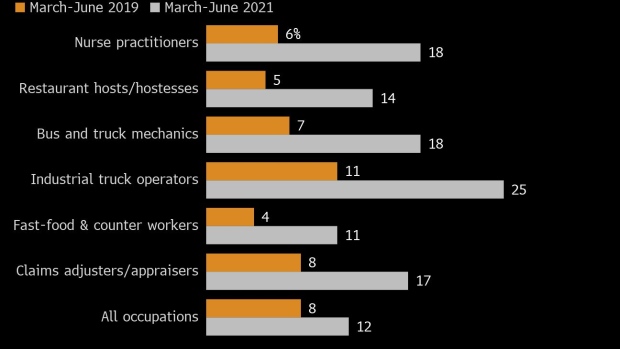Jul 31, 2021
More Job Ads Disclose Wages as U.S. Employers Grow Desperate
, Bloomberg News

(Bloomberg) -- Sign up for the New Economy Daily newsletter, follow us @economics and subscribe to our podcast.
A rising number of U.S. job listings are including wage ranges as employers compete for cooks, truck operators and other scarce workers.
The lack of transparency on pay has long been a scourge of job seekers, and recent data suggest that the tight labor market may be starting to force companies’ hands.
Around 12% of listings across all occupations offered salary information in the second quarter, up from 8% in the same period in 2019, according to analytics firm Emsi Burning Glass.
The biggest gains were in hard-to-find positions such as restaurant hosts and nurse practitioners, for which almost one in five ads now disclose pay, according to Burning Glass, which analyzes millions of offers for trends.
The number of offers disclosing wages remains a small minority, but the shift could embolden workers. President Joe Biden has called rising wages “a feature” of his economic plan, and in a recent CNN town hall event said the hospitality and tourism industries may be “in a bind for a while” as workers hold out for better wages and working conditions.
Employers historically have been reluctant to show their cards publicly, fearing that they’ll have to pay more than a job seeker is willing to accept, or that current employees will grouse about being underpaid.
However, some state legislators are trying to force the issue, arguing that women and minorities are more hesitant to negotiate with employers and fall behind their White male counterparts in pay.
The day when most employers are transparent about wages can’t come soon enough for Kristen Ware, a 22-year-old in Rock Hill, South Carolina, seeking a marketing job.
“I would like to know how much a company is going to pay me, because I don’t know how much a recent graduate should be getting paid,” said Ware, who complained about the lack of pay disclosures on a Facebook forum. ”We shouldn’t have to guess all the time what’s the best pay for me.”
Colorado Law
A new law in Colorado requires that companies with any presence in the state post wage information in their job ads. That holds even for positions that can be done remotely from outside of Colorado, and the state’s Department of Labor and Employment has been following up on tips about companies that aren’t compliant.
Maryland and California also have laws requiring companies to provide wage ranges to job applicants upon request, and Connecticut will soon require companies to disclose wage ranges for open jobs to both applicants and existing employees.
“Colorado is nudging the country toward having a more informed labor market,” said Scott Moss, director of the division of labor standards and statistics at the Colorado labor department.
Burning Glass compared 2021 with prepandemic 2019 instead of last year to get a clearer picture of changes, and focused on employer-sponsored job sites, filtering out public job boards that sometimes include their own wage estimates.
The Rocky Mountain states, including Colorado, saw more than a 300% increase in job listings that include salaries, but the numbers grew in most other regions, too, the data show. The Great Lakes region rose 29%, the Mid East rose 35% and the Southeast and Southwest rose 54% and 61%, respectively. The Far West and New England were two regions that saw small declines.
Tim Dupree, president of staffing giant Kelly Services’ Professional and Industrial unit, chalks up some of the gains to “leakage” from Colorado. Forced to disclose pay in that state, some employers are probably including the information in other states as well. Other companies are being very public with their wages to signal they’re no longer a low-paying operation, he said. As he drives around his Michigan base, Dupree sees warehouses and manufacturers touting their $17-an-hour wages out front.
“They’re probably using it as a way to drive messaging as an employer brand,” Dupree said. “Those former employers that were paying $9, $10, $11 an hour are now paying $15 or $16.”
There’s still a long way to go before full pay transparency in offers, and data from other sources provide mixed signals.
Adzuna, an international job board with a U.S. headquarters in Indianapolis, found that only 1.5% of ads across occupations included wage information in June, actually down slightly from two years earlier. However, the company did see big gains in competitive industries, including trade and construction, where the percentage of ads with wages has quadrupled since June 2019.
Unlike Burning Glass, Adzuna included ads from public job boards as well as from companies’ own websites.
Kimberly Harris, who runs career fairs around the country from her base in Charlotte, North Carolina, has been pushing her corporate clients to disclose wages.
“When we include pay ranges or pay rates, the responses would triple,” Harris said. “We want honesty and we want transparency.”
©2021 Bloomberg L.P.